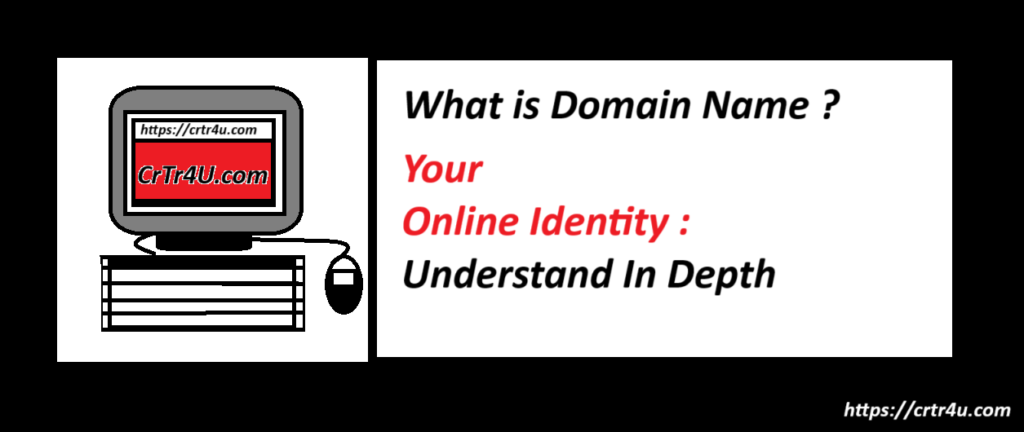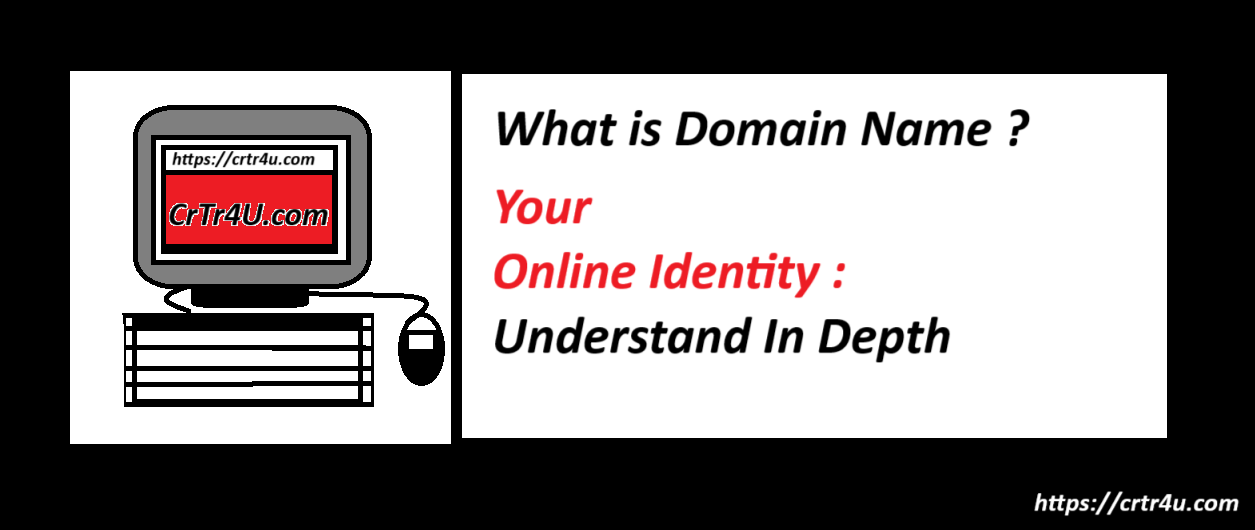What is a Domain Name?
A domain name is a human-readable address for a website or other resource on the internet. It’s like a street address for a physical location, but instead of pointing to a physical place, it points to a specific computer or server on the internet.
For example , if you want to visit our website, you would type “crtr4u.com” into your web browser. This domain name tells your computer where to find our website on the internet.
The purpose of domain names is to make it easier for people to remember and access websites.
Instead of remembering complex numerical addresses (called IP addresses), we can use easy-to-remember domain names.
How Domain Names Work: A Technical Breakdown
Domain Name Registration
1.Choosing a Registrar: You select a domain name registrar, which is a company that manages domain name registrations.
Example : GoDaddy is a popular domain name registrar. It’s one of the largest companies in the world that provides domain name registration, web hosting, and other online services.
2.Searching for Availability: You search for the desired domain name. If it’s available, you can proceed with registration.
Example : visit GoDaddy official website(https://www.godaddy.com/) there you can type domain name you want and search it, for example , for my website i wanted domain name as “crtr4u” , so , I visited godaddy.com , and on home page there was a search box , where I typed and searched , whether crtr4u.com is available or not.
3.Payment and Registration: You pay the registration fee, and the registrar adds your domain name to the Domain Name System (DNS).
Example: if domain name is available you can purchase it online , please create your account on any registrars official website(example : godaddy.com ) and then you can search domain name and then buy it online.
Domain Name Resolution
1.DNS Lookup: When you type a domain name into your web browser, your computer sends a DNS lookup request to a DNS server.
2.DNS Server: The DNS server checks its database for the corresponding IP address of the domain name.
3.IP Address Retrieval: If the DNS server finds the IP address, it sends it back to your computer.
4.Connection Establishment: Your computer then uses the IP address to connect to the web server hosting the website associated with the domain name.
5.Website Loading: The web server sends the website’s content to your computer, and your browser displays it.
Key Components:
Domain Name System (DNS): A distributed database that stores the mapping between domain names and IP addresses.
Domain Name Registrars: Companies that manage domain name registrations and provide DNS services.
IP Addresses: Unique numerical addresses assigned to devices on the internet.
In essence, domain names act as a bridge between human-readable names and machine-readable IP addresses, making it easy for users to access websites and other online resources.
Just Imagine , if domain names are not there then you may need to type and remember IP addresses to visit a website on internet. Now here what you will remember domain name “crtr4u.com” or Numerical IP Address(sample) “92.112.183.151” , its always simple to remember domain names right ?
Niche-Specific Domain Names
Country-Specific Domain Names
Understanding the use of country-specific domain extensions: Country-specific domain extensions, also known as ccTLDs (country code top-level domains), can help you target specific geographic regions. For example, .fr for France, and .de for Germany , .in for India. These extensions can improve your website’s local search engine rankings and credibility.
Industry-Specific Domain Names
Choosing domain names that reflect your industry or niche: Selecting a domain name that clearly indicates your industry or niche can help attract the right audience. For example, if you’re in the Gym Bag or health industry, you might consider a domain name like “gymbag4u.com”
Personal Brand Domain Names
Creating a personal brand domain name for your online presence: A personal brand domain name can help you establish your online identity and create a professional online presence. It can be a great way to showcase your work, share your expertise, and connect with your audience. For example, a writer might use “[Author’s Name].com,” while a speaker might use “[Speaker’s Name].com.”
When choosing a niche-specific domain name, consider the following:
Relevance: Ensure the domain name is directly related to your industry or niche.
Memorability: Choose a domain name that is easy to remember and spell.
Availability: Check if the desired domain name is available for registration.
Keyword relevance: Incorporate relevant keywords into your domain name to improve search engine optimization (SEO).
Brand ability: Consider how the domain name fits with your overall brand identity.
By carefully selecting a niche-specific domain name, you can create a stronger online presence and attract your target audience more effectively.

Avoiding Common Pitfalls When Selecting a Domain Name :
1.Keep it simple and easy to remember: Avoid complex words or numbers that might be difficult to spell or remember.
2.Make it relevant: Choose a domain name that is relevant to your business or website’s topic.
3.Avoid hyphens and numbers: Hyphens and numbers can make domain names harder to remember and type.
4.Consider the future: Think about how your domain name might evolve with your business.
5.Check for availability: Use a domain name search tool to check if your desired domain name is available.
6.Avoid trademarks: Be careful not to infringe on any existing trademarks.
7.Consider the .com extension: While other extensions are available, .com is still the most popular and recognizable.
8.Avoid offensive or inappropriate language: Choose a domain name that is appropriate for your target audience.
9.Test it out: Type your domain name out loud to see if it’s easy to say and remember.
10.Get feedback: Ask friends and family for their opinion on your domain name.
By following these tips, you can increase your chances of selecting a domain name that is both memorable and effective for your online presence.
Domain Name Disputes and Resolution
Domain name disputes can arise for various reasons, including:
Trademark infringement: When a domain name infringes on a registered trademark.
Cyber squatting: When someone registers a domain name with the intent to profit from the goodwill associated with a well-known brand or trademark.
Disputes between parties: When there are disagreements between multiple parties over the ownership or use of a domain name.
Resolving Domain Name Disputes
There are several ways to resolve domain name disputes:
- Direct Negotiation: Parties involved in a dispute can attempt to resolve it through direct negotiations or mediation.
- Uniform Domain Name Dispute Resolution Policy (UDRP): This is an international arbitration procedure specifically designed to resolve domain name disputes. It is administered by the Internet Corporation for Assigned Names and Numbers (ICANN).
- Court System: In some cases, domain name disputes can be resolved through the court system.
To protect your domain name from disputes, consider the following:
Register your trademark: Register your trademark to establish ownership and protect it from infringement.
Monitor for infringements: Regularly monitor for domain names that may infringe on your trademark or brand.
Consider a trademark watch service: Use a trademark watch service to help you identify potential infringements.
Take action promptly: If you discover a domain name that infringes on your trademark, take prompt action to resolve the dispute.
By understanding the potential for domain name disputes and taking proactive steps to protect your domain name, you can help minimize the risk of legal issues and maintain your online presence.
Happy Learning.



